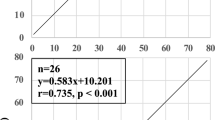Abstract
Rapid and reliable detection of inadvertent endobronchial intubation is an essential function of oxygen monitoring. We have studied the detection of this event by using three oxygen monitoring techniques: pulse oximetry, transcutaneous measurement of oxygen tension, and intraarterial fiberoptic measurement of oxygen tension. Four dogs were anesthetized, intubated, and monitored with these three techniques and with arterial and central venous cannulas. Endotracheal tubes were moved from the trachea into the right mainstem bronchi at several inspired oxygen fraction (FIO2) values for each dog, and the responses of the oxygen monitors were recorded for 20 minutes thereafter.
The pulse oximeter showed little change in oxygen saturation (SpO2) during endobronchial intubation at FIO2 values above 0.3. SpO2 decreased by an average of 1.3±2.1% at an FIO2 of 1.0 and by 4.0±4.1% at an FIO2 of 0.5 Simultaneously measured transcutaneous oxygen tensions decreased by 42 to 64% and the optode reading decreased by 64 to 79%. At lower FIO2 values, the changes in SpO2 were more significant: a decrease of 6.0±6.3% at an FIO2 of 0.3 and of 9.8±6.1% at an FIO2 of 0.2. The transcutaneous oxygen and optode readings decreased by 31 to 45% under these conditions.
Endobronchial intubations at FIO2 values greater than 0.3 may not yield immediate decreases in arterial saturation and hence may go undetected by pulse oximetry. Transcutaneous oxygen tension decreases significantly with endobronchial intubation at any FIO2. The experimental intraarterial optode consistently yielded the greatest changes with the fastest time response.
Similar content being viewed by others
References
Brodsky J, Shulman M, Swan M, Mark J. Pulse oximetry during one-lung ventilation. Anesthesiology 1985;63:212–214
Thys D, Cohen E, Eisenkraft J, Kaplan J. The pulse oximeter, a noninvasive monitor of oxygenation during one-lung anesthesia. Anesth Analg 1985;64:292
Tremper K, Konchigeri H, Cullen B, et al. Transcutaneous monitoring of oxygen tension during one-lung anesthesia. J Thorac Cardiovasc Surg 1984;88(1):22–25
Salmenpera M, Heinonen J. Transcutaneous oxygen measurement during one-lung anesthesia. Acta Anesthesiol Scand 1984;28:241–244
Chung M, Lichtor J, Rangachari K. Transcutaneous monitoring of PO2 and PCO2 during one-lung anesthesia. Anesthesiology 1984;61(3A):A164
Peterson JI, Fitzgerald RV. Fiber-optic probe for in vivo measurement of oxygen partial pressure. Anal Chem 1984;56:62–67
Gehrich JL, Lubbers DW, Opitz N, et al. Optical fluorescence and its application to an intravascular blood gas monitoring system. IEEE Trans Biomed Eng 1986;BME-33:117–132
Barker SJ, Tremper KK, Hyatt J, et al. Continuous fiberoptic arterial oxygen tension measurements in dogs. J Clin Monit 1987;3:48–52
Barker SJ, Tremper KK, Heitzmann HA. A clinical study of fiber-optic arterial oxygen tension. Crit Care Med 1987;15:403
American Society of Anesthesiologists. Standards for basic intraoperative monitoring. Anesthesia Patient Safety Newsletter. 1987 March: p 3
Glenski JR, Thibeault DW, Hall RT, et al. Selective bronchial intubation in infants with lobar emphysema: indications, complications, and long-term outcome. Am J Perinatol 1986;3(3):199–204
Coté CJ, Liu LM, Szyfelbein SK, et al. Intraoperative events diagnosed by expired carbon dioxide monitoring in children. Can Anaesth Soc J 1986;33(3 Pt I):315–320
Roxburgh JC. Rupture of the tracheobronchial tree. Thorax 1987;42(9):681–688
Owen RL, Cheney FW. Endobronchial intubation: a preventable complication. Anesthesiology 1987;67(2):255–257
Tremper KK, Shoemaker WC. Transcutaneous oxygen monitoring of critically ill adults, with and without low flow shock. Crit Care Med 1981;9:706–709
Author information
Authors and Affiliations
Rights and permissions
About this article
Cite this article
Barker, S.J., Tremper, K.K., Hyatt, J. et al. Comparison of three oxygen monitors in detecting endobronchial intubation. J Clin Monitor Comput 4, 240–243 (1988). https://doi.org/10.1007/BF01617319
Received:
Revised:
Accepted:
Issue Date:
DOI: https://doi.org/10.1007/BF01617319




